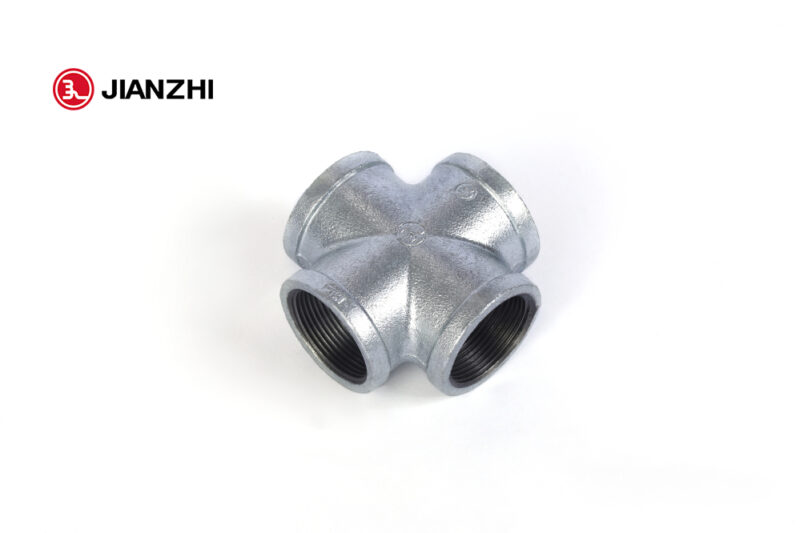A 4-way structural pipe connector is a specialized component used in building and construction applications, particularly in the assembly of scaffolding, modular structures, and various frameworks. It plays a critical role in creating stable and secure structures by providing connections for four pipes or tubes at right angles to each other. These connectors are designed to facilitate the assembly and disassembly of modular systems, such as scaffolding, and contribute to the versatility and adaptability of structural designs.
Functions of a 4-way structural pipe connector:
- Joining Pipes: The primary function of a 4-way structural pipe connector is to securely join four pipes or tubes at right angles to each other. This enables the creation of cross beams and junction points in a structural framework.
- Stability: By connecting multiple pipes in a cross pattern, these connectors help distribute loads evenly across all connected pipes, enhancing the stability and load-bearing capacity of the structure.
- Modularity: 4-way structural pipe connectors are essential components in modular construction systems. They allow for the quick and easy assembly and disassembly of structures, making them ideal for applications where flexibility and adaptability are necessary.
- Versatility: These connectors are compatible with a wide range of pipe or tube sizes, making them versatile for various construction projects. They can be used with steel, aluminum, or other materials depending on the application.
- Safety: The use of 4-way structural pipe connectors contributes to the safety of construction and maintenance workers by providing stable platforms for work in elevated positions, such as scaffolding.
- Load Distribution: The design of these connectors helps evenly distribute loads, ensuring that the structure can support heavy equipment and materials safely.
- Corner Bracing: In addition to supporting horizontal and vertical beams, 4-way structural pipe connectors are commonly used for corner bracing in construction frameworks. This adds rigidity to the structure and helps maintain square and level alignments.
- Customizable Configurations: They allow for the creation of customized structures by connecting pipes in various configurations, such as grids, rectangular frames, and platforms.
Overall, 4-way structural pipe connectors are key components in the construction industry, offering a versatile and efficient solution for building scaffoldings, platforms, and frameworks used in a variety of applications, including construction, maintenance, and events like concerts and outdoor exhibitions. Their ease of use, adaptability, and capacity to support heavy loads make them a valuable asset in the construction and engineering sectors.
Are there industry standards or regulations that govern the design and use of 4-way structural pipe connectors to ensure safety and quality?
Yes, industry standards and regulations exist to govern the design and use of 4-way structural pipe connectors to ensure safety and quality in construction and related applications. These standards help establish best practices and guidelines for manufacturers, engineers, and construction professionals. While specific regulations may vary by region, some widely recognized standards and guidelines include:
- OSHA Standards: In the United States, the Occupational Safety and Health Administration (OSHA) sets safety standards for construction and workplace safety. OSHA regulations cover various aspects of construction, China 4 way structural pipe connector including the use of scaffoldings and related components. These standards provide guidance on the safe use and construction of scaffolds, which often incorporate 4-way structural pipe connectors.
- ANSI/ASSE A10.8 Standard: The American National Standards Institute (ANSI) and the American Society of Safety Engineers (ASSE) have established ANSI/ASSE A10.8, a standard that addresses safety requirements for scaffoldings. This standard includes guidelines for the use of scaffold components, including connectors and fittings.
- ASTM International Standards: ASTM International, formerly known as the American Society for Testing and Materials, develops and publishes a range of standards related to materials, components, and systems used in construction. Some ASTM standards pertain to scaffolding and scaffold components.
- Local Building Codes: Many regions and municipalities have building codes that include specific requirements for the design and use of scaffolding and related components. These local codes may reference national or international standards, but they can also include additional requirements specific to the local area.
- Manufacturer Specifications: Manufacturers of 4-way structural pipe connectors and related scaffolding components often provide detailed specifications and guidelines for the proper use, installation, and maintenance of their products. It’s important to follow these manufacturer-specific instructions.
- Construction Industry Standards: Various organizations within the construction industry, such as the Scaffold & Access Industry Association (SAIA) in the United States, publish guidelines and best practices related to scaffolding and scaffold components.
- Professional Engineer Oversight: In some cases, the involvement of a professional engineer may be required to ensure that scaffolding structures, including the use of 4-way structural pipe connectors, meet safety and quality standards. Engineers play a crucial role in the design and approval of scaffolding systems.
Compliance with these standards and regulations is vital to ensure the safety of construction workers and the quality and integrity of scaffold structures. It’s essential for construction professionals to be aware of the specific standards and regulations that apply to their region and to follow them diligently when working with 4-way structural pipe connectors and related components. Additionally, regular inspections and maintenance are critical to ensure that scaffolding remains safe and functional.

